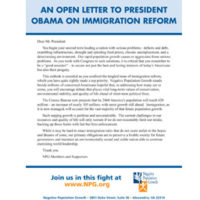Little Known Presidential Population Leadership
- Otis L. Graham, Jr
- January 19, 2013
- Forum Papers
- Forum Paper
- 0 Comments
What, exactly, was Sustainable Development (SD)? A 1987 UN Commission chaired by Norwegian Prime Minister Gro Bruntland had defined SD, in their book Our Common Future, as “Development that meets the needs of the present without compromising the ability of future generations to meet their own needs.” The phrase caught on as a concise and “balanced” statement of goals for human societies with a “fairness” and “sharing” vocabulary that appealed to the Left and the young. The phrase multiplied rapidly during the 1990s. Communities, states, companies, philanthropic and social reform groups declared that they were sustainable, or intended to be by some date certain. Sustainable institutes and centers proliferated on university campuses, as when in Autumn, 2012 my campus (Santa Barbara) of the University of California boasted 35 student organizations working on sustainability. Sustainable high schools in Oregon built haybalelined classrooms to control air quality. The island Santa Catalina off the California coast, running out of water in 2011, found that their search for a consultant on the water problem turned up an impressive firm specializing in and called Sustainable Communities, based in Colorado. Sustainability was a full-service term of many uses, and at the outset with no enemies. Yet even the fans of sustainability admitted that it was a fuzzy term much in need of clarification.
* * *
It is not clear from his published presidential papers or from books on his presidency whether or when Clinton understood that in launching his Council he might be wandering into a briarpatch, or, instead, catching up to and engaging a promising social movement. Or both?
If he needed positive encouragement, it could have come from any or all of his top green Lieutenants who had frequently written on the hazards made more acute by global population expansion. The three were the president’s Science Advisor John Holdren, who had been in his academic days a frequent writer (often jointly with Paul Ehrlich) on the hazards of global overpopulation. The second was former Colorado Senator Timothy Wirth, whose population interests led Clinton to appoint him as Assistant-Secretary of State for Global Affairs. The third was that fellow down the hall from Clinton, Al Gore, and it was the Vice-President (the Democratic Party presidential nominee in 2000) who managed the PCSD when Clinton was away.
- Little Known Presidential Population Leadership - January 19, 2013
- Immigration Reform and America’s Unchosen Future - November 3, 2009
- Immigration and America’s Unchosen Future - September 10, 2009

